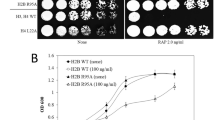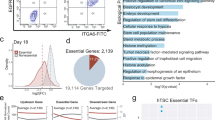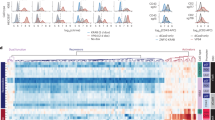Abstract
Chinese hamster cells have large interstitial (TTAGGG) bands (ITs) which are unstable and should be protected by an unknown mechanism. Here, we expressed in Chinese hamster V79 cells green fluorescent protein (GFP)-tagged human TRF1, and found that a major fraction of GFP-TRF1 bound to ITs is diffusionally mobile. This fraction strongly decreases after treatment of cells with wortmannin, a protein kinase inhibitor, and this drug also increases the frequency of chromosome aberrations. Ionizing radiation does not induce detectable translocation of GFP-TRF1 to the sites of random double-strand breaks visualized using antibodies against histone γ-H2AX. TRF1 is known to be eliminated from telomeres by overexpression of tankyrase 1 which induces TRF1 poly(ADP-ribosyl)ation. We transfected V79 cells by plasmid encoding tankyrase 1 and found that the frequency of chromosome rearrangements is increased in these cells independently of their treatment by IR. Taken together, our results suggest that TRF1 is involved in sequence-specific protection of internal nontelomeric (TTAGGG)n repeats.
This is a preview of subscription content, access via your institution
Access options
Subscribe to this journal
Receive 50 print issues and online access
$259.00 per year
only $5.18 per issue
Buy this article
- Purchase on SpringerLink
- Instant access to full article PDF
Prices may be subject to local taxes which are calculated during checkout






Similar content being viewed by others
Abbreviations
- ATM:
-
Ataxia teleangiectasia-mutated protein
- CA:
-
chromosome aberration
- DSB:
-
double-strand DNA break
- GFP:
-
green fluorescent protein
- IT:
-
internal non-telomeric blocks of (TTAGGG)n sequences
- NHEJ:
-
nonhomologous end-joining
References
d'Adda di Fagagna F, Hande MP, Tong WM, Roth D, Lansdorp PM, Wang ZQ and Jackson SP . (2001). Curr. Biol., 11, 1192–1196.
Allen C, Kurimasa A, Brenneman MA, Chen DJ and Nickoloff JA . (2002). Proc. Natl. Acad. Sci. USA, 99, 3758–3763.
Allio I and Preston RJ . (2000). Mutat. Res., 453, 5–15.
Alvarez L, Evans JW, Wilks R, Lucas JN, Brown JM and Giaccia AJ . (1993). Genes Chromosom. Cancer, 8, 8–14.
Azzalin CM, Nergadze SG and Giulotto E . (2001). Chromosoma, 110, 75–82.
Bailey SM, Meyne J, Chen DJ, Kurimasa A, Li GC, Lehnert BE and Goodwin EH . (1999). Proc. Natl. Acad. Sci. USA, 96, 14899–14904.
Baumann P and Cech TR . (2001). Science, 292, 1171–1175.
Bertoni L, Attolini C, Faravelli M, Simi S and Giulotto E . (1996). Mamm. Genome, 7, 853–855.
Boulton S, Kyle S, Yalcintepe L and Durkacz BW . (1996). Carcinogenesis, 17, 2285–2290.
Burma S, Chen BP, Murphy M, Kurimasa A and Chen DJ . (2001). J. Biol. Chem., 276, 42462–42467.
Chernikova SB, Wells RL and Elkind MM . (1999). Radiat. Res., 151, 159–166.
Chong L, van Steensel B, Broccoli D, Erdjument-Bromage H, Hanish J, Tempst P and de Lange T . (1995). Science, 270, 1663–1667.
Cortez D, Wang Y, Qin J and Elledge SJ . (1999). Science, 286, 1162–1166.
Cost GJ and Boeke JD . (1998). Biochemistry, 37, 18081–18093.
Cost GJ, Golding A, Schlissel MS and Boeke JD . (2001). Nucleic Acids Res., 29, 573–577.
Day JP, Limoli CL and Morgan WF . (1998). Carcinogenesis, 19, 259–265.
de Lange T . (2002). Oncogene, 21, 532–540.
Faravelli M, Azzalin CM, Bertoni L, Chernova O, Attolini C, Mondello C and Giulotto E . (2002). Gene, 283, 11–16.
Ferguson DO and Alt FW . (2001). Oncogene, 20, 5572–5579.
Fernandez JL, Gosalvez J and Goyanes V . (1995). Chromosome Res., 3, 281–284.
Fernandez JL, Goyanes VJ, Ramiro-Diaz J and Gosalvez J . (1998). Cytogenet. Cell Genet., 82, 195–198.
Flint J, Craddock CF, Villegas A, Bentley DP, Williams HJ, Galanello R, Cao A, Wood WG, Ayyub H and Higgs DR . (1994). Am. J. Hum. Genet., 55, 505–512.
Gatei M, Young D, Cerosaletti KM, Desai-Mehta A, Spring K, Kozlov S, Lavin MF, Gatti RA, Concannon P and Khanna K . (2000). Nat. Genet., 25, 115–119.
Gilley D, Tanaka H, Hande MP, Kurimasa A, Li GC, Oshimura M and Chen DJ . (2001). Proc. Natl. Acad. Sci. USA, 98, 15084–15088.
Gineitis AA, Zalenskaya IA, Yau PM, Bradbury EM and Zalensky AO . (2000). J. Cell Biol., 151, 1591–1598.
Goytisolo FA and Blasco MA . (2002). Oncogene, 21, 584–591.
Griffith J, Bianchi A and de Lange T . (1998). J. Mol. Biol., 278, 79–88.
Hande MP, Balajee AS, Tchirkov A, Wynshaw-Boris A and Lansdorp PM . (2001). Hum. Mol. Genet., 10, 519–528.
Hsu HL, Gilley D, Blackburn EH and Chen DJ . (1999). Proc. Natl. Acad. Sci. USA, 96, 12454–12458.
Hsu HL, Gilley D, Galande SA, Hande MP, Allen B, Kim SH, Li GC, Campisi J, Kohwi-Shigematsu T and Chen DJ . (2000). Genes Dev., 14, 2807–2812.
Jeggo PA, Carr AM and Lehmann AR . (1998). Trends Genet., 14, 312–326.
Jurka J . (1997). Proc. Natl. Acad. Sci. USA, 94, 1872–1877.
Kilburn AE, Shea MJ, Sargent RG and Wilson JH . (2001). Mol. Cell. Biol., 21, 126–135.
Kim SH, Kaminker P and Campisi J . (1999). Nat. Genet., 23, 405–412.
Kishi S and Lu KP . (2002). J. Biol. Chem., 277, 7420–7429.
Kishi S, Zhou XZ, Ziv Y, Khoo C, Hill DE, Shiloh Y and Lu KP . (2001). J. Biol. Chem., 276, 29282–20991.
Krutilina RI, Oei S, Buchlow G, Yau PM, Zalensky AO, Zalenskaya IA, Bradbury EM and Tomilin NV . (2001). Biochem. Biophys. Res. Commun., 280, 471–475.
Lippincott-Schwartz J, Snapp E and Kenworthy A . (2001). Nat. Rev. Mol. Cell. Biol., 2, 444–456.
Meyne J, Baker RJ, Hobart HH, Hsu TC, Ryder OA, Ward OG, Wiley JE, Wurster-Hill DH, Yates TL and Moyzis RK . (1990). Chromosoma, 99, 3–10.
Misteli T, Gunjan A, Hock R, Bustin M and Brown DT . (2000). Nature, 408, 877–881.
Morgan WF, Hartmann A, Limoli CL, Nagar S and Ponnaiya B . (2002). Mutat. Res., 504, 91–100.
Okabe J, Eguchi A, Masago A, Hayakawa T and Nakanishi M . (2000). Hum. Mol. Genet., 9, 2639–2650.
Pandita TK . (2001). Radiat. Res., 156 (Part 2), 642–647.
Pandita TK . (2002). Oncogene, 21, 611–608.
Pandita TK and DeRubeis D . (1995). Cytogenet. Cell Genet, 68, 95–101.
Pandita TK, Pathak S and Geard CR . (1995). Cytogenet. Cell Genet., 71, 86–93.
Radman M . (1991). Biochimie, 73, 357–361.
Rogakou EP, Boon C, Redon C and Bonner WM . (1999). J. Cell Biol., 146, 905–916.
Samper E, Goytisolo FA, Slijepcevic P, van Buul PP and Blasco MA . (2000). EMBO Rep., 1, 244–252.
Sarkaria JN, Tibbetts RS, Busby EC, Kennedy AP, Hill DE and Abraham RT . (1998). Cancer Res., 58, 4375–4382.
Sekiguchi J, Ferguson DO, Chen HT, Yang EM, Earle J, Frank K, Whitlow S, Gu Y, Xu Y, Nussenzweig A and Alt FW . (2001). Proc. Natl. Acad. Sci. USA, 98, 3243–3248.
Shen M, Haggblom C, Vogt M, Hunter T and Lu KP . (1997). Proc. Natl. Acad. Sci. USA, 94, 13618–13623.
Simi S, Attolini C and Giulotto E . (1998). Mutat. Res., 397, 229–233.
Slijepcevic P and Bryant PE . (1995). Cytogenet. Cell Genet., 69, 87–89.
Slijepcevic P, Xiao Y, Dominguez I and Natarajan AT . (1996). Chromosoma, 104, 596–604.
Smilenov LB, Mellado W, Rao PH, Sawant SG, Umbricht CB, Sukumar S and Pandita TK . (1998). Oncogene, 17, 2137–2142.
Smith GP . (1976). Science, 191, 528–535.
Smith S, Giriat I, Schmitt A and de Lange T . (1998). Science, 282, 1484–1487.
Smith S and de Lange T . (2000). Curr. Biol., 10, 1299–1302.
Smogorzewska A, van Steensel B, Bianchi A, Oelmann S, Schaefer MR, Schnapp G and de Lange T . (2000). Mol. Cell. Biol., 20, 1659–1668.
Song K, Jung D, Jung Y, Lee SG and Lee I . (2000). FEBS Lett., 481, 81–85.
Sprung CN, Reynolds GE, Jasin M and Murnane JP . (1999). Proc. Natl. Acad. Sci. USA, 96, 6781–6786.
Taylor AM, Metcalfe JA, Thick J and Mak YF . (1996). Blood, 87, 423–438.
Tomilin NV, Solovjeva LV, Svetlova MP, Pleskach NM, Zalenskaya IA, Yau PM and Bradbury EM . (2001). Radiat. Res., 156, 347–354.
van Steensel B and de Lange T . (1997). Nature, 385, 740–743.
Yoshida M, Kijima M, Akita M and Beppu T . (1990). J. Biol. Chem., 265, 17174–17179.
Zalensky AO, Tomilin NV, Zalenskaya IA, Teplitz RL and Bradbury EM . (1997). Exp. Cell Res., 232, 29–41.
Zhao S, Weng YC, Yuan SS, Lin YT, Hsu HC, Lin SC, Gerbino E, Song MH, Zdzienicka MZ, Gatti RA, Shay JW, Ziv Y, Shiloh Y and Lee EY . (2000). Nature, 405, 473–477.
Zhong Z, Shiue L, Kaplan S and de Lange T . (1992). Mol. Cell. Biol., 12, 4834–4843.
Acknowledgements
We thank S Smith for her kind gift of plasmids pTetFLNLS and pUHR15-1. This research was supported by the Office of Science (BER), US Department of Energy, Grant No. DE-FG03-01ER63070, by the National Institutes of Health Grant No. 5R01-HD39830-02, by the Deutsche Forschung Gemeinschaft Grant 436 RUS113/126/0, by the Civilian Research and Development Foundation Grant ST-012-0 and the Russian Fund for Basic Research Grants 01-04-49486 and 02-04-49145.
Author information
Authors and Affiliations
Corresponding author
Rights and permissions
About this article
Cite this article
Krutilina, R., Smirnova, A., Mudrak, O. et al. Protection of internal (TTAGGG)n repeats in Chinese hamster cells by telomeric protein TRF1. Oncogene 22, 6690–6698 (2003). https://doi.org/10.1038/sj.onc.1206745
Received:
Revised:
Accepted:
Published:
Issue date:
DOI: https://doi.org/10.1038/sj.onc.1206745
Keywords
This article is cited by
-
Ubiquitin C-terminal hydrolase isozyme L1 is associated with shelterin complex at interstitial telomeric sites
Epigenetics & Chromatin (2017)
-
Telomere binding protein TRB1 is associated with promoters of translation machinery genes in vivo
Plant Molecular Biology (2016)
-
Transcriptional outcome of telomere signalling
Nature Reviews Genetics (2014)
-
The human TTAGGG repeat factors 1 and 2 bind to a subset of interstitial telomeric sequences and satellite repeats
Cell Research (2011)
-
Different DNA-PKcs functions in the repair of radiation-induced and spontaneous DSBs within interstitial telomeric sequences
Chromosoma (2011)



